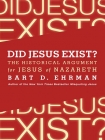Did Jesus Exist? - The Historical Argument for Jesus of Nazareth Bart Ehrman (books to read in your 20s txt) 📖

- Author: Bart Ehrman
Book online «Did Jesus Exist? - The Historical Argument for Jesus of Nazareth Bart Ehrman (books to read in your 20s txt) 📖». Author Bart Ehrman
The Oral Traditions About Jesus
THE FURTHER QUESTION THAT needs to be asked is where all these Gospel sources—Mark, Q, M, L, sayings source, passion narratives, proto-Thomas and so on—got their stories. This is a question that has occupied New Testament scholars for nearly a hundred years. In the early part of the twentieth century there was a group of scholars in Germany who developed a method of studying the Gospels to address this question. The method has traditionally been called, in English, “form criticism.”
Form Criticism and Oral Traditions About Jesus
The original impetus for the form-critical approach to the Gospels came from a well-known New Testament scholar named Karl Ludwig Schmidt; the approach was developed, in different ways, by the even more famous Martin Dibelius and especially by the most famous of them all, Rudolf Bultmann, arguably the greatest and most influential scholar of the New Testament in the twentieth century.14
These form critics were principally interested in knowing what happened while the stories about Jesus were being transmitted orally. Their assumption was that after Jesus’s life, when Christian missionaries founded churches throughout the Mediterranean, stories about Jesus were told and retold in various kinds of situations that Christians found themselves in. These scholars were called “form” critics because they wanted to know how different kinds of stories came to assume the shape or form they have. Why is it that so many miracle stories seem to follow the same basic pattern? A person comes up to Jesus, his or her problem (or illness) is described, there is a brief interchange with Jesus, Jesus agrees to heal the person, he does so by a word or by a touch, and all the crowds marvel. Every miracle story seems to have the same elements.
Or take the controversy stories. Jesus or his disciples do something that offends the Jewish leaders; the leaders protest; Jesus has a conversation with them; and the story ends with Jesus delivering a withering one-liner that shows that he gets the better of them. Time after time, same form.
The form critics were invested in two issues: what was the “situation in life” (German: Sitz im Leben) in which different kinds of stories about Jesus were told? And how did the various kinds of stories assume their various forms (so that there is one kind of form for miracle stories, another for controversy stories, and so on)? These critics did not agree among themselves on the specifics of their views. But their overarching understanding of the oral traditions about Jesus was fairly consistent. The stories about Jesus came to be shaped in the process of telling and retelling, as they assumed their characteristic forms. This means that the stories were changed, sometimes radically, when they were retold, and thus formed over the years. And some stories were made up in the process, developed to speak to the needs the Christian communities and to address the situations they found themselves in. If a community, for example, was facing opposition from the Jews of the local synagogue because they did not observe the Sabbath laws strictly, they might come up with a story in which Jesus himself was confronted by his Jewish opponents over the same issue. And watch! Jesus outshines his opponents by delivering a devastating rejoinder to their objections.
So far as I know, there are no longer any form critics among us who agree with the precise formulations of Schmidt, Dibelius, and Bultmann, the pioneers in this field. But the most basic idea behind their approach is still widely shared, namely, that before the Gospels came to be written, and before the sources that lie behind the Gospels were themselves produced, oral traditions about Jesus circulated, and as the stories about Jesus were told and retold, they changed their form and some stories came to be made up. I have already intimated that this was the case when speaking about the sources M and L, when I conceded that these may not have simply been written documents but entirely or partly oral traditions. This appears to be true of all of our sources for the historical Jesus. They are all based on oral traditions, and this has significant implications for our quest to determine if Jesus actually lived.
The reality appears to be that there were stories being told about Jesus for a very long time not just before our surviving Gospels but even before their sources had been produced. If scholars are right that Q and the core of the Gospel of Thomas, to pick just two examples, do date from the 50s, and that they were based on oral traditions that had already been in circulation for a long time, how far back do these traditions go? Anyone who thinks that Jesus existed has no problem answering the question: they ultimately go back to things Jesus said and did while he was engaged in his public ministry, say, around the year 29 or 30. But even anyone who just wonders if Jesus existed has to assume that there were stories being





Comments (0)